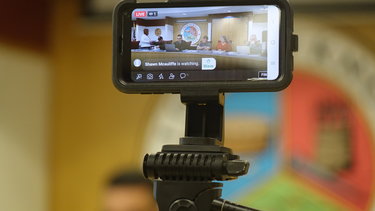Local governments should be required to livestream meetings, says report
ALBANY COUNTY — During the height of the COVID-19 pandemic, virtually every municipality in New York state live streamed their meetings; now, less than a quarter do, according to a report from the New York Coalition for Open Government and the Cornell University State Policy and Advocacy Clinic.
The ability to watch a livestream or archived recording of a local government meeting was a boon for citizens, the report says, and particularly those who are older, have physical disabilities, or have young family members to look after, the report says.
But the Cornell clinic — whose disability-rights team “has been working to expand public participation in government decision making by advocating for increased remote accessibility in open meetings” — found that of the 1,240 municipalities reviewed, only 285 have continued to produce a livestream or recording.
The strongest predictor of whether a local government offered a remote viewing option appears to be its population, with only 13 percent of towns and villages with a population of under 5,000 still streaming, compared to 38 percent of those with populations above 5,000, according to the report.
Incidentally, the smaller municipalities were less likely to have data available to review, the report notes, with 13 percent having no data available, compared to 7 percent for the larger municipalities, the report notes.
When grouping municipalities by county, there was a correlation between county wealth and livestream rates, but there were notable exceptions, such as Tompkins County, which the report describes as having a relatively high poverty rate but the highest streaming rate by far, with 11 out of 13 of its municipalities participating. (Cornell is located in Tompkins County along with Ithaca College, Wells College and Tompkins Cortland Community College.)
Also, Broome County, which had the highest poverty rate in the state as of 2020, had a streaming rate that was slightly above average, according to the report — 25 percent compared to the statewide rate of 23 percent, the report says.
Broadband access may play a role when looking at regional trends, with Western New York, the Southern Tier, and the Mohawk Valley having the lowest regional streaming rate while containing several counties that have lower-than-average access to broadband, the report says. It also notes that many rural municipalities, which are more likely to have poor broadband access, use live streaming.
The report also looks at the most common platform for streaming, with the top three being Zoom (36 percent); YouTube (34 percent); and “other” (17 percent), which the report said served as a bucket for municipalities that had vague information about their platform or used “relatively rare streaming tools, including public TV, radio, and less popular websites.”
Noting that it is “not difficult or expensive to livestream and post recordings online,” the report singles out Rensselaerville — itself a rural, low-population town — as an example of one that streams relatively cheaply to Facebook, using an iPad managed by the supervisor’s clerk, Carolyn Bauer.
Bauer told The Enterprise this week that the town also uses a “separate, low-cost microphone which is just a little bit better than the iPad microphone.”
Likewise, in Knox, resident Brigitte McAuliffe took it upon herself to livestream meetings to Facebook using her phone.
Facebook, like YouTube, is a cost-free streaming platform, meaning that only equipment cost and a stable internet connection is required. Zoom, the most popular platform, requires a paid account to broadcast a meeting for more than 40 minutes, and does not automatically archive the content the way social-media platforms do.
The free social-media platforms do not, however, offer viewers the option to interact, but this is not a requirement, and can be an unnecessary complication.
In Guilderland, Supervisor Peter Barber told The Enterprise in an email that the town is “in the process of updating our website and broadcasting equipment which would provide the opportunity for audience participation by virtual means.”
Barber said that the town needs to devise a way to prevent bad-faith participants from disrupting meetings remotely.
“The Town's broadcast has a delay (I think seven seconds) to mute improper language or stop video broadcast,” he said. “It requires syncing the two systems.”
In Rensselaerville, anyone who has business before the town board would still need to attend in person, but those who only wish to observe can either watch the meeting live on Facebook or pull up the recording on the town’s page whenever they wish.
Beyond increasing participation, a further benefit of live streaming meetings is that the recordings currently function as a board’s minutes under the state’s Open Meetings Law, meaning that clerks would no longer be under pressure to publish written minutes within the two-week deadline set by the state (or, in many cases, would no longer be in violation of the law for not publishing them).
Rensselaerville Town Clerk Kraker told The Enterprise that she has the minutes finished within two weeks anyway, since the town board meets twice a month and votes to approve minute drafts at each meeting. The Guilderland Town Board is also current on its written minutes.
The report says that Oregon and Indiana have passed laws requiring local governments to livestream and publish recordings of meetings, and calls on New York to be an “early leader and adopter.”
“The COVID pandemic changed how the world operates in so many ways. Remote and hybrid meetings have become a new way of life that have many positive aspects,” the report says.
“Local governments,” it goes on, “need to evolve with the times and the technology available to conduct hybrid meetings is not that difficult or expensive. Many local governments with small populations and budgets have figured out how to do hybrid meetings.
“We support providing additional funding to local governments to address any technology needs or assistance required so that they can livestream and record their meetings.”



